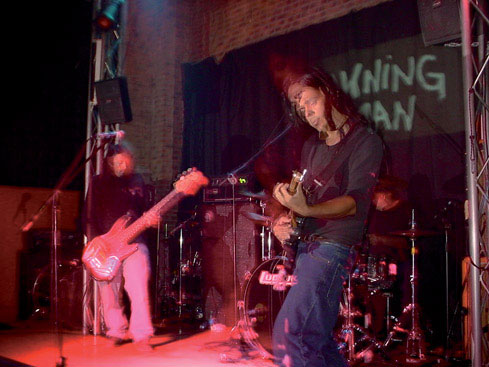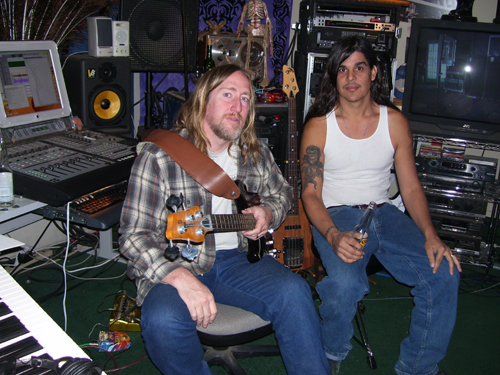Yawning Man is a product of 1980s California. Four guys in their late teens shacked up in a house in La Quinta, a desert town tucked in the Coachella Valley at the southern end of the state, about an hour-and-a-half from the Mexican border. They were Alfredo Hernandez, a jazz-trained drummer; Mario Lalli, bass player and house keeper; Larry Lalli on guitar and Gary Arce, the principle designer behind Yawning Man’ languid, elemental, tempestuous rock music.
This is where desert rock began, and by extension stoner rock, a certain melancholy inflected psychedelica borne from sweltering, lethargic desert towns in the south east of the United States. The music of Yawning Man is cinematic, suffused with American outsider dreams, grand in scale but uniformly focused. Yawning Man’ sound was birthed in the sweaty, unemployed and beery daze of Arce, heretofore untrained at his guitar, and an already proficient Hernandez on his kit. Speaking on the phone from La Quinta, Arce describes the setting in their home circa 1985.
“Mario’s parents owned this house in the desert and we all lived there, crashed there, partied, did whatever,” Arce recalls. “Me and Alfredo didn’t have jobs, so during the day when Mario was at work we’d wake up in the morning, start drinking beer and start jamming. I really didn’t know how to write songs, I just self-taught myself on Mario’s guitar when he was at work. We started coming up with music, a sound.”
Musicians often purport to have “a sound”, but very few can claim to have emphatically created one, an aesthetic previously unknown and subsequently rendered in varying degrees of authenticity throughout the subsequent history of rock music. Although Yawning Man took 17 years to record their proper debut album Rock Formations, the band created a thundering, vagrant form of psychedelic rock, the aural equivalent of wandering parched through the infinite yellow. It’s remarkable how gentle and empathising Arce’s sustained, reverberated guitar notes sound as they ring high on the fret board, or how Hernandez’s kit can wander in and out of focus so precisely – intricate and bereft of showmanship. These young guys, who recorded a few low-key demos but otherwise stayed clear of the commercial realms for the bulk of their career, are owed debts from bands like Kyuss and Queens of the Stone Age, among others.
Back then punk was the modus operandi of young rebel Californians. Greg Ginn’s SST records spawned bands such as Black Flag, the Descendents and the Minutemen, who were all either functioning or in the process of disbanding while Yawning Man were sharing their La Quinta home. The band used to drive to LA to see shows, which is where they met Dave Travis, a teacher, filmmaker and musician who introduced the members to the idea of holding concerts, parties, in the desert.

Arce says that although there were bands playing live shows in the desert throughout the 70s, it started for Yawning Man when “Travis came to the desert one weekend with a truck full of friends and a generator.”
“He turned us onto the whole thing with the generator parties. He’d come down every weekend and we’d load all of our equipment into his truck, and get everyone around. Sometimes the parties would get really huge. Sometimes we’d get 500 people out there! There’d be moonlight and live music until five in the morning. Just people taking acid and drinking beer.”
At first, the Iron Door was the meeting spot for desert revellers. It was a location tucked away from the view of police and prudes, and the location for some of Yawning Man’ first shows, played to blissed-out onlookers, lazing in the sand or leaning against their vehicles.
But the Iron Door was not to be forever. “Eventually the cops started showing up there, and it started getting pretty bad for a while,” says Arce. “A lot of the people would be drunk, and bottles would start flying at parked cars. Eventually it came to an end, and we found another spot called Edom Hill.”
“Edom Hill was a big mountain out here in the desert owned by the city. There was a gate that was open on the weekends, so we’d tell everybody to meet up at Edom Hill on Saturday nights.”
One particularly windy night at Edom Hill, Arce and co set up their gear on the hill and embarked on one of their marathon jams. It became so windy that onlookers were forced into their cars at the foot of the hill, to watch from the cockpit of their vehicles, headlights ablaze to illuminate the desert ensemble while they endured the tumult of sand and storm. When the band finally reconvened in 2002 after a long hiatus for the release of Rock Formations and the subsequent Pot Head EP (both originally released on Spanish label Alone records, now re-released together as Vista Point on Australia’s Lexicon Devil Records), those romantic moments were nearly two decades vintage. Yawning Man are no longer a group of teenagers spending hot days in hammocks wrapping their heads around new instruments and new sounds.
Yawning Man turned into A Sort Of Quartet when the members started implementing elements of bebop into their sound. Alfredo Hernandez went on to guest in Kyuss and Queens of the Stone Age, the Lalli cousins founded Fatso Jetson, while Gary Arce has joined Ten East and started his own project Dark Tooth Encounter, which follows a darker, more caustic energy while still maintaining Arce’s flair for immersion. Yawning Man have plans to record a new album slated for release late in 2008.
For now, Gary Arce is living in the same La Quinta house that birthed Yawning Man, having bought it from the Lalli family. He lives there with his family, has a job, and the desert scene is a thing of the past.
“The desert has changed a lot since the 80s. A lot of houses have been built, a lot of land developed.”
“The Iron Door is shut down now.” Arce mourns, “and Edom Hill is now a rubbish dump.”
Yawning Man’s Vista Point is available from Lexicon Devil/Fuse.




